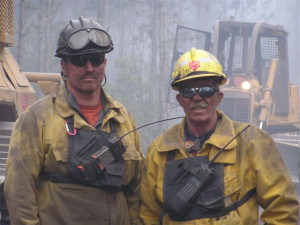
Fourteen years ago, the Georgia Forestry Commission was leading an intense battle against one of the worst fires in U.S. history. A downed power line sparked the blaze on April 16, 2007, southwest of Waycross. It was named the Sweat Farm Fire, and it consumed 20,000 acres in the first 48 hours alone. By April 21 it had spread into the Okefenokee Wildlife Refuge. Extreme drought and heavy fuel loads made it easy for other fires to ignite and by May 5, wildland firefighters were struggling to get the upper hand on the renamed “Georgia Bay Complex.” When it was deemed contained in July, it had decimated more than 564,450 acres in Georgia and Florida, damaged nine homes and gobbled up $65 million dollars in timber.
Those who served on the fire, from Georgia and almost every other state in the nation, have vivid memories about the destruction, the hardships and the dangers involved in managing the many challenges involved. Strategic attacks were carried out by tractor-plows, engine crews, hand crews and air operations, though at times the smoke was so thick, equipment operators became disoriented and needed help to find their way out.
Georgia Forestry Commission Protection Chief Frank Sorrells remembers fearing for his crews who were in open-air cabs, enveloped by dense, black smoke. At one point, Sorrells radioed them directions to blast their horns, so rescuers could pinpoint their locations. It was then that Sorrells also realized the enclosed cabs Alabama firefighters used were what he needed in Georgia. Since that time, the Georgia legislature has provided funding to GFC for those types of heavy equipment, significantly enhancing operator safety.
The fire left behind much more than ashes. It taught important lessons about the changing volatility of wildfire and the importance of increased planning and wildfire protection strategies. Sorrells said the agency has established a permanent fire break around the perimeter of the Okefenokee Swamp, which is a valuable and important part of wildfire management. This firebreak, referred to as Swamp Edge Break, provides an “anchor point” to wildfire suppression resources when fires move out of the Okefenokee Swamp into upland areas. It also serves as a ready escape route and potential safety zone for personnel.
Another solution was found after water shortages in the area hampered operations. When the Okefenokee Swamp burns during periods of drought and low water tables, water sources to support both engine and helicopter bucket operations are limited. Because of the remoteness of most areas, engines must travel long distances on unimproved roads to “refill locations,” and helicopters fly many miles away to suitable ponds and lakes to refill buckets. This creates long turn-around periods for water supply. Sorrells said they learned that small ponds, or “helicopter dip sites” could be dug to create sufficient water refill locations at strategic places near the swamp’s perimeter to provide for the quick return of helicopters and engines delivering water to wildfires. Today, 74 helicopter dip sites are maintained and mapped to support wildfires within three miles of the Okefenokee Swamp Perimeter.
Former Georgia Forestry Commission Director Robert Farris also shared a memory that provides insight into the nature of a GFC wildland firefighter.
“I’d gone to a refueling site where the tractors were coming in. The wind changed and smoke just dropped down; you couldn’t see anything. A dozen of our big tractors were coming in to refuel and the ground was just shaking, rumbling towards you and you can’t see two feet in front of ya. And I start worrying – about them for one, about me for the other. Are they gonna run over my car? How can they see? And then, in time, you can see dimly some headlights coming forward. And they pull up to the refuel site and start getting off their tractors. And I don’t recognize them. They’re just head to toe with soot and smoke. When they take off their goggles, of course, I recognize them. And they’re smiling and happy – in the worst of conditions.”
